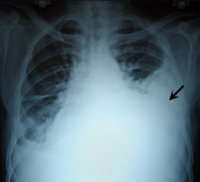
Photo from wikipedia
To investigate the expression profile of monocyte chemoattractant peptide-1 (MCP-1) by keratinocytes after nickel exposure and to identify its role for leucocyte migration during nickel-induced occupational allergic contact dermatitis (OACD),… Click to show full abstract
To investigate the expression profile of monocyte chemoattractant peptide-1 (MCP-1) by keratinocytes after nickel exposure and to identify its role for leucocyte migration during nickel-induced occupational allergic contact dermatitis (OACD), 26 workers diagnosed with nickel-induced OACD were enrolled. Skin biopsies from the positive nickel-challenged sites at different time points were assessed by immunohistochemistry (IHC) for MCP-1, CD68, CD45RO, and in situ hybridization (ISH) for MCP-1, using chronic periumbilical dermititis as controls. The expressions of MCP-1 in HaCaT cell culture after nickel treatment were quantified by enzyme-linked immunosorbent assay. The results showed that at positive nickel-challenged sites, strong expressions of MCP-1, both messenger RNA (mRNA) and protein, were detected in the basal keratinocytes during the early phase (24–48 h after nickel application), paralleled by the recruitment of CD68+ and CD45RO+ cells to the skin compartments. The expressions of MCP-1 declined gradually in the late phase (72–96 h after nickel application). Treatment with nickel sulfate at noncytotoxic concentrations (0.01–100 µM) induced a concentration-related elevation of MCP-1 expression by HaCaT cells compared to the untreated cells. The data indicated that a temporal expression pattern of MCP-1 produced by keratinocytes after nickel exposure was involved in the complex process of mononuclear cell infiltration during elicitation of nickel-induced OACD. Targeting MCP-1 might be a potential therapeutic strategy for OACD.
Journal Title: Toxicology and Industrial Health
Year Published: 2018
Link to full text (if available)
Share on Social Media: Sign Up to like & get
recommendations!